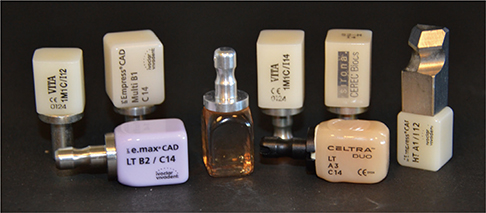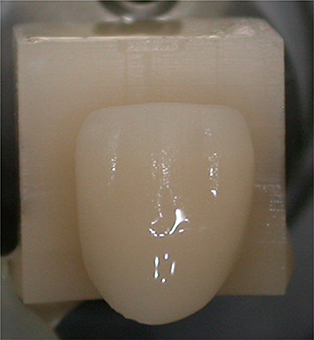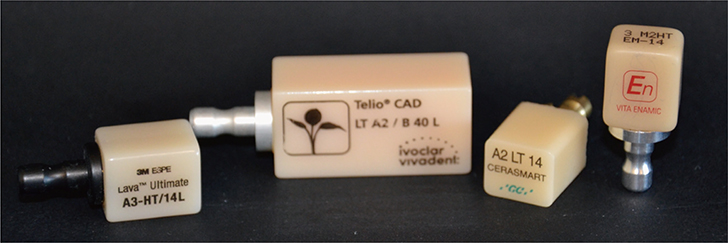J Adv Prosthodont.
2017 Dec;9(6):486-495. 10.4047/jap.2017.9.6.486.
Dental biomaterials for chairside CAD/CAM: State of the art
- Affiliations
-
- 1Department of Prosthodontics, Faculty of Odontology, Montpellier University, Montpellier, France. dr.hugo.lambert@hotmail.com
- 2Preventive Department, Faculty of Odontology, Marseille University, Marseille, France.
- 3Laboratoire de Bioingénérie et Nanosciences, EA 4203, Montpellier University, Montpellier, France.
- KMID: 2398055
- DOI: http://doi.org/10.4047/jap.2017.9.6.486
Abstract
- The wide use of chairside CAD/CAM restorations has increased the diversity of the restorative material. For the practitioner, the selection of the appropriate material is difficult amongst the variety offered by the market. Information on the characteristics of the products can be difficult to assess due to the lack of up-to-date classification and the lack of reliability of manufacturer's advertising. The purpose of this article is to structure the data on restorative materials provided by various sources in order for the practitioner to choose the product most suited to the clinical situation. The objective is to classify chairside CAD/CAM materials and to define their characteristics and indications.
Figure
Cited by 1 articles
-
In vivo wear determination of novel CAD/CAM ceramic crowns by using 3D alignment
Akın Aladağ, Didem Oğuz, Muharrem Erhan Çömlekoğlu, Ender Akan
J Adv Prosthodont. 2019;11(2):120-127. doi: 10.4047/jap.2019.11.2.120.
Reference
-
1. Davidowitz G, Kotick PG. The use of CAD/CAM in dentistry. Dent Clin North Am. 2011; 55:559–570.2. Li RW, Chow TW, Matinlinna JP. Ceramic dental biomaterials and CAD/CAM technology: state of the art. J Prosthodont Res. 2014; 58:208–216.3. Bindl A, Mörmann WH. Clinical and SEM evaluation of allceramic chair-side CAD/CAM-generated partial crowns. Eur J Oral Sci. 2003; 111:163–169.4. Vichi A, Sedda M, Del Siena F, Louca C, Ferrari M. Flexural resistance of Cerec CAD/CAM system ceramic blocks. Part 1: Chairside materials. Am J Dent. 2013; 26:255–259.5. Sannino G, Germano F, Arcuri L, Bigelli E, Arcuri C, Barlattani A. CEREC CAD/CAM chairside system. Oral Implantol (Rome). 2015; 7:57–70.6. Nguyen JF, Migonney V, Ruse ND, Sadoun M. Resin composite blocks via high-pressure high-temperature polymerization. Dent Mater. 2012; 28:529–534.7. Ruse ND, Sadoun MJ. Resin-composite blocks for dental CAD/CAM applications. J Dent Res. 2014; 93:1232–1234.8. Oh KT, Kim KN. Electrochemical properties of suprastructures galvanically coupled to a titanium implant. J Biomed Mater Res B Appl Biomater. 2004; 70:318–331.9. Tuna SH, Pekmez NO, Keyf F, Canli F. The electrochemical properties of four dental casting suprastructure alloys coupled with titanium implants. J Appl Oral Sci. 2009; 17:467–475.10. Kelly JR. Dental ceramics: what is this stuff anyway? J Am Dent Assoc. 2008; 139:4S–7S.11. Kelly JR. Dental ceramics: current thinking and trends. Dent Clin North Am. 2004; 48:513–530.12. Kelly JR, Benetti P. Ceramic materials in dentistry: historical evolution and current practice. Aust Dent J. 2011; 56:84–96.13. Giordano R 2nd. A comparison of all-ceramic restorative systems: Part 2. Gen Dent. 2000; 48:38–40. 43–45.14. Deany IL. Recent advances in ceramics for dentistry. Crit Rev Oral Biol Med. 1996; 7:134–143.15. Kelly JR. Ceramics in Restorative and Prosthetic Dentistry. Annu Rev Mater Sci. 1997; 27:443–468.16. Gracis S, Thompson VP, Ferencz JL, Silva NR, Bonfante EA. A new classification system for all-ceramic and ceramic-like restorative materials. Int J Prosthodont. 2015; 28:227–235.17. Vichi A, Carrabba M, Paravina R, Ferrari M. Translucency of ceramic materials for CEREC CAD/CAM system. J Esthet Restor Dent. 2014; 26:224–231.18. Bindl A, Lüthy H, Mörmann WH. Strength and fracture pattern of monolithic CAD/CAM-generated posterior crowns. Dent Mater. 2006; 22:29–36.19. Stawarczyk B, Beuer F, Ender A, Roos M, Edelhoff D, Wimmer T. Influence of cementation and cement type on the fracture load testing methodology of anterior crowns made of different materials. Dent Mater J. 2013; 32:888–895.20. Özcan M, Bernasconi M. Adhesion to zirconia used for dental restorations: a systematic review and meta-analysis. J Adhes Dent. 2015; 17:7–26.21. Krejci I, Lutz F, Reimer M. Wear of CAD/CAM ceramic inlays: restorations, opposing cusps, and luting cements. Quintessence Int. 1994; 25:199–207.22. Ma L, Guess PC, Zhang Y. Load-bearing properties of minimal-invasive monolithic lithium disilicate and zirconia occlusal onlays: finite element and theoretical analyses. Dent Mater. 2013; 29:742–751.23. Pieger S, Salman A, Bidra AS. Clinical outcomes of lithium disilicate single crowns and partial fixed dental prostheses: a systematic review. J Prosthet Dent. 2014; 112:22–30.24. Nawafleh N, Hatamleh M, Elshiyab S, Mack F. Lithium disilicate restorations fatigue testing parameters: A systematic review. J Prosthodont. 2016; 25:116–126.25. Rinke S, Rödiger M, Ziebolz D, Schmidt AK. Fabrication of Zirconia-Reinforced Lithium Silicate Ceramic Restorations Using a Complete Digital Workflow. Case Rep Dent. 2015; 2015:162178.26. Denry I, Kelly JR. Emerging ceramic-based materials for dentistry. J Dent Res. 2014; 93:1235–1242.27. Subbarao EC. Zirconia - an overview Advances in Ceramics. American Ceram Soc. 1981; 1–24.28. Kisi EH, Howard CJ. Crystal structures of zirconia phases and their inter-relation. Key Eng Mater. 1998; 153-4:1–36.29. Denry I, Kelly JR. State of the art of zirconia for dental applications. Dent Mater. 2008; 24:299–307.30. Filser F, Kocher P, Gauckler LJ. Net-shaping of ceramic components by direct ceramic machining. Assem Autom. 2003; 23:382–390.31. Daou EE. Esthetic Prosthetic Restorations: Reliability and Effects on Antagonist Dentition. Open Dent J. 2015; 9:473–481.32. Chevalier J, Deville S, Münch E, Jullian R, Lair F. Critical effect of cubic phase on aging in 3mol% yttria-stabilized zirconia ceramics for hip replacement prosthesis. Biomaterials. 2004; 25:5539–5545.33. Kojima Y, Matsuoka T, Takahashi H. Structure of poly (methyl methacrylate) synthesized under high pressure. J Mater Sci Lett. 2002; 21:473–475.34. Van Noort R. An introduction to dental materials. Resin composites and polyacid-modified resin composites. Mosby Ltd.;2002. p. 96–123.35. Albers HF. Tooth-colored restoratives: Principles and techniques. Resins. PMPH-USA;2002. p. 111–125.36. Rawls H, Esquivel-Upshaw J. Restorative resins. Phillip's Sci Dent Mater;2003. p. 399–441.37. Mainjot AK, Dupont NM, Oudkerk JC, Dewael TY, Sadoun MJ. From Artisanal to CAD-CAM Blocks: State of the Art of Indirect Composites. J Dent Res. 2016; 95:487–495.38. Knobloch LA, Kerby RE, Seghi R, van Putten M. Two-body wear resistance and degree of conversion of laboratory-processed composite materials. Int J Prosthodont. 1999; 12:432–438.39. Lovell LG, Newman SM, Bowman CN. The effects of light intensity, temperature, and comonomer composition on the polymerization behavior of dimethacrylate dental resins. J Dent Res. 1999; 78:1469–1476.40. Ferracane JL, Condon JR. Post-cure heat treatments for composites: properties and fractography. Dent Mater. 1992; 8:290–295.41. Bausch JR, de Lange C, Davidson CL. The influence of temperature on some physical properties of dental composites. J Oral Rehabil. 1981; 8:309–317.42. Goldberg M. In vitro and in vivo studies on the toxicity of dental resin components: a review. Clin Oral Investig. 2008; 12:1–8.43. Goldberg M, Dimitrova-Nakov S, Schmalz G. BPA from dental resin material: where are we going with restorative and preventive dental biomaterials. Clin Oral Investig. 2014; 18:347–349.44. Wiegand A, Stucki L, Hoffmann R, Attin T, Stawarczyk B. Repairability of CAD/CAM high-density PMMA- and composite-based polymers. Clin Oral Investig. 2015; 19:2007–2013.45. Dirxen C, Blunck U, Preissner S. Clinical performance of a new biomimetic double network material. Open Dent J. 2013; 7:118–122.46. Della Bona A, Corazza PH, Zhang Y. Characterization of a polymer-infiltrated ceramic-network material. Dent Mater. 2014; 30:564–569.47. Coldea A, Swain MV, Thiel N. Mechanical properties of polymer-infiltrated-ceramic-network materials. Dent Mater. 2013; 29:419–426.48. Rocca GT, Bonnafous F, Rizcalla N, Krejci I. A technique to improve the esthetic aspects of CAD/CAM composite resin restorations. J Prosthet Dent. 2010; 104:273–275.49. Giordano R. Materials for chairside CAD/CAM-produced restorations. J Am Dent Assoc. 2006; 137:14S–21S.
- Full Text Links
- Actions
-
Cited
- CITED
-
- Close
- Share
- Similar articles
-
- Chairside computer-aided design/computer-aided manufacturing (CAD/ CAM)-based restoration of anterior teeth with customized shade and surface characterization: a report of 2 cases
- CAD/CAM fabricated complete denture using 3D face scan: A case report
- Survey study on the Preference of Dental Medical Personnel for Dental CAD/CAM Milling Machines
- Computer-guided implant surgery and immediate provisionalization by chair-side CAD-CAM: A case report
- Comparative fracture strength analysis of Lava and Digident CAD/CAM zirconia ceramic crowns




